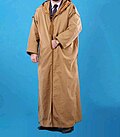Qashabiya
 Men wearing the qashabiya | |
| Material | Camel hairandwool |
|---|---|
| Place of origin | Algeria |
Theqashabiya(Arabic:القشابية) is a traditionalArabwinter garment originating fromAlgeria.It features a hood and differs from theburnousby the presence of sleeves and a closure. Thicker and wider than theDjellaba(الجلابة), it is made of camel wool. It allows its wearer to brave the wind and precipitation of winter.
It also holds significant importance in the Algeriancollective memory,as it, along with the burnous, represents the attire of theshuhadaduring theAlgerian War of National Liberation.It also has the reputation of being Algeria's national attire.
Etymology[edit]
Arabicdictionaries list several definitions and etymologies for the term qashabiya, although they all agree in designating a garment but differ in its characteristics.
According to Georges Séraphin Colin, the arab term "qeššabiya"used in central and eastern Algeria is a deformation of the Latin gausapa, a term that would have been preserved in the form of gosaba in the Adrar, where it refers to a shirt.[1]
Origin[edit]

The Qashabiya, a characteristic garment symbol of the High Plateaus ofAlgeria,is mainly crafted in the heart ofDjelfaand its surroundings. It can also be found in the eastern regions ofMorocco,theAurès,Tunisia,and even as far asTripolitania.
These regions form a cultural and ethnic continuum based on an Arab andBedouinsociety whose primary activity remains pastoralism and camel breeding.[2]The geographic space of the Qashabiya corresponds to that of the arid and dry plateaus of theSaharan Atlaswhere winters and nights are harsh. It is a region mainly inhabited by Arab tribes, the Sehari,Hamyan,Ouled Nail,Rahman, and 'Umur, renowned for their expertise in camel domestication and the exploitation of theirwool.
To speak of the qashabiya is to raise the question of the place of the camel inNorth Africanculture. Indeed, camel wool, called al-Wabr (الوبر) in Arabic, occupies a central place in Algerian craftsmanship inherited from the country's Bedouin traditions.
The use of al-Wabr by Arabs to protect themselves from the cold is ancient and varied. It is found in most male attire of theMashreqand ruralMaghreb.Names of cities and places such as 'Ain Al-Ibl (Djelfa) or 'Ain Al-Nagah (Biskra) testify to the importance of the camel in the cultural landscape of the Algerian High Plateaus. This wool is harvested by nomads during shearing and is used for the manufacture of burnouses, tents, qashabiya, and other clothing. Sheep wool (as-Sawf) is sometimes added to this hair in the qashabiya manufacturing process.[3]
Fabrication[edit]
The know-how and crafting of the qashabiya are mainly feminine. Even today, it is the Bedouin woman who is in charge of all stages of production. This ranges from scouring the wool (ashm) to weaving (sadwah).[4]
See also[edit]
References[edit]
- ^E. B (1995-11-01)."Djellaba".Encyclopédie berbère(in French) (16): 2425–2427.doi:10.4000/encyclopedieberbere.2181.ISSN1015-7344.Retrieved2022-12-04.
- ^M. El Moujabber; H. Belhouchette; M. Belkhodja; P. Kalaïtzis; R. Cosentino; W. Occhialini."Research and innovation as tools for sustainable agriculture, food and nutrition security: extended abstracts and papers".cjoint.Retrieved2024-01-21.
- ^M. El Moujabber; H. Belhouchette; M. Belkhodja; P. Kalaïtzis; R. Cosentino; W. Occhialini."Research and innovation as tools for sustainable agriculture, food and nutrition security: extended abstracts and papers".cjoint.Retrieved2024-01-21.
- ^M. El Moujabber; H. Belhouchette; M. Belkhodja; P. Kalaïtzis; R. Cosentino; W. Occhialini."Research and innovation as tools for sustainable agriculture, food and nutrition security: extended abstracts and papers".cjoint.Retrieved2024-01-21.
- Meguellati-Kanoun, Amel; Abdelali-Martini, Malika; Kanoun, Mohamed; Benmebarek, Abdelmadjid; Benidir, Mohamed (2013-12-17). "The potential loss of traditional know-how of qashabiya production in Djelfa, Algeria". In Malika Abdelali-Martini; Aden Aw-Hassan (eds.).Gender Research in Natural Resource Management: Building Capacities in the Middle East and North Africa.Routledge. pp. 37–55.ISBN978-1-317-91634-5.
- Benmebarek, Abdelmadjid; Larbi Cherfaoui, Mohamed; Ouazane, H.; Abdelali-Martini, Maliki; Meguellati-Kanoun, Amel; Kanoun, Mohamed; Fodil, Souhila (2013-12-17). "Gender and Marketing of qashabiya in Djelfa (Algeria)". In Malika Abdelali-Martini; Aden Aw-Hassan (eds.).Gender Research in Natural Resource Management: Building Capacities in the Middle East and North Africa.Routledge. pp. 56–73.ISBN978-1-317-91634-5.

